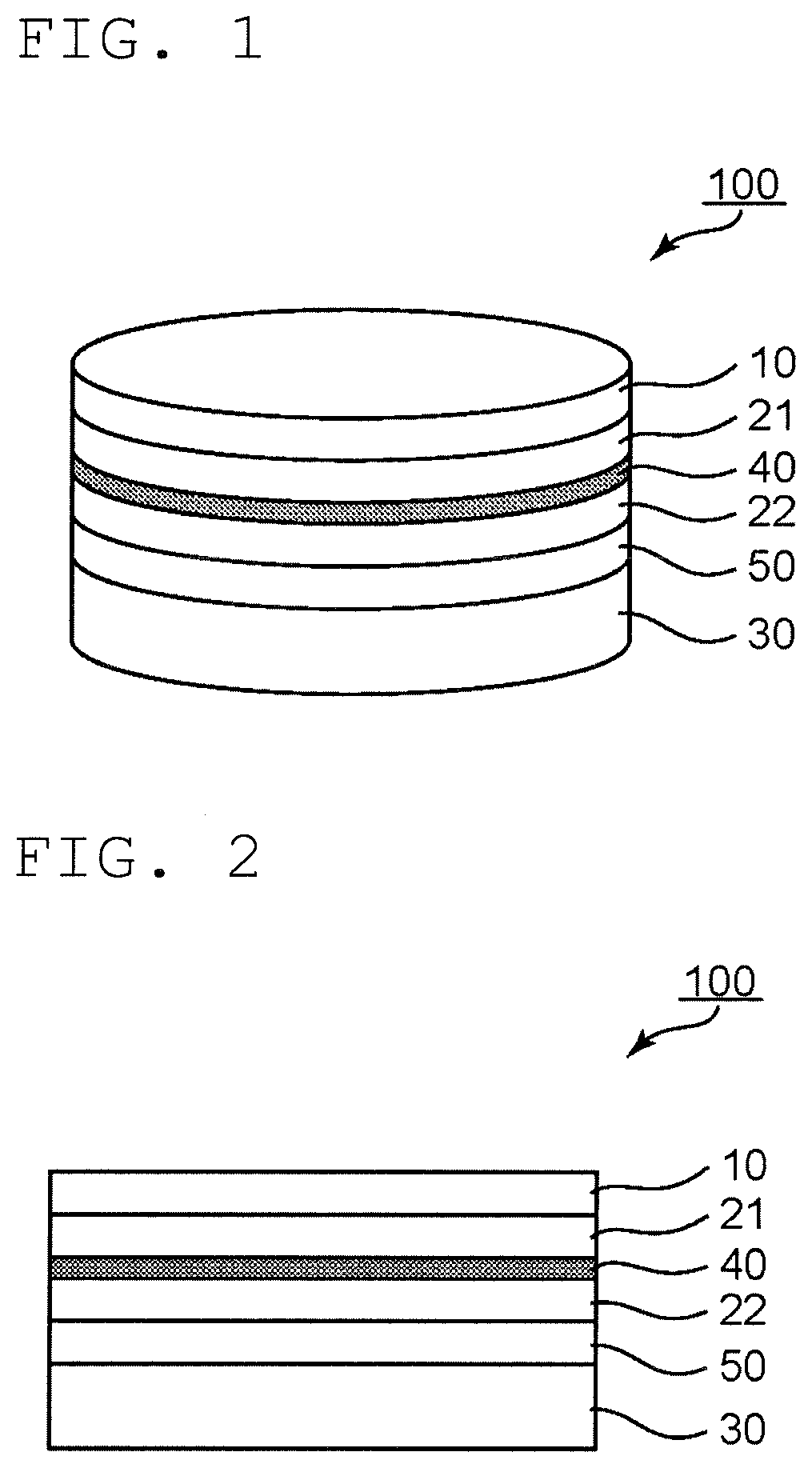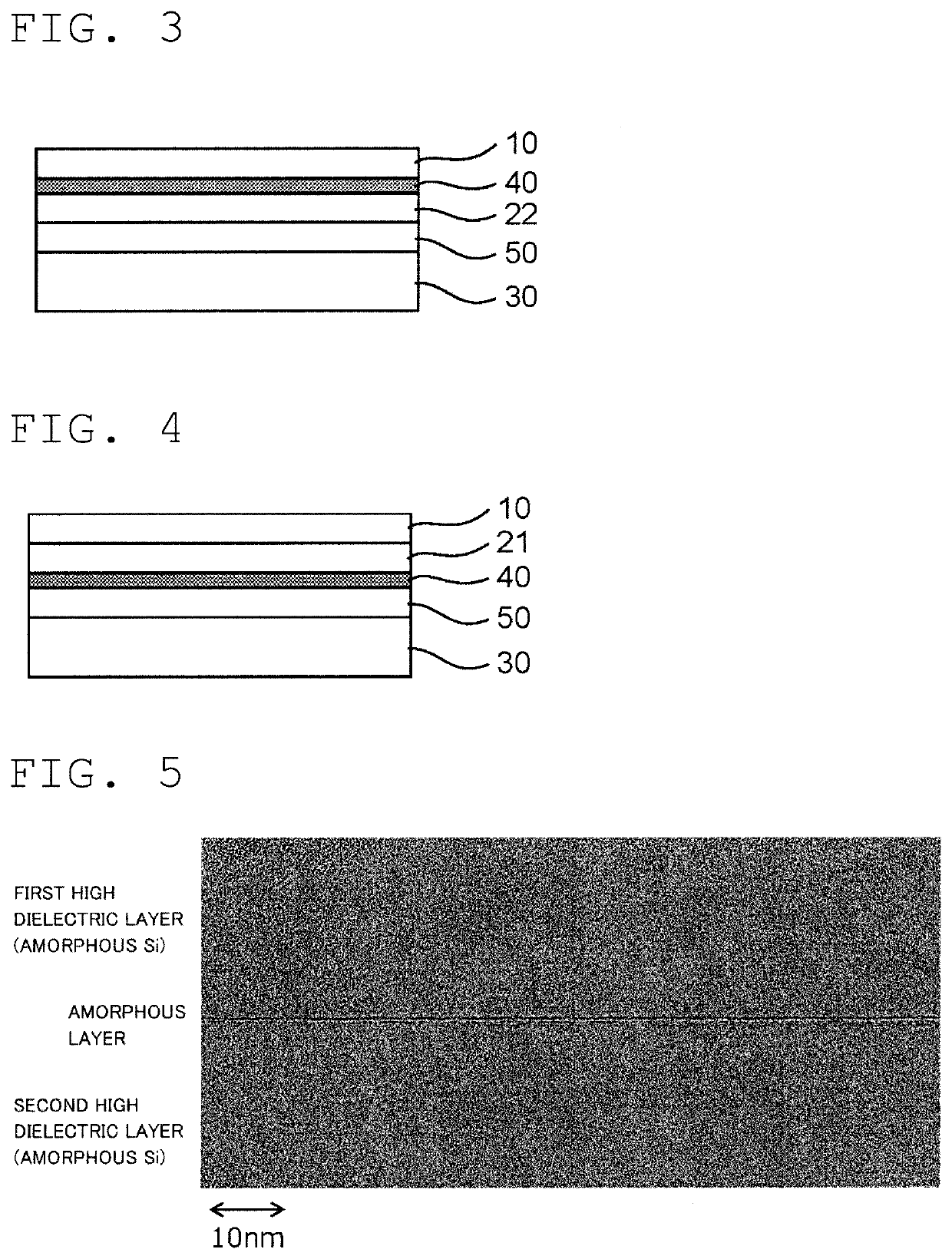Composite substrate for electro-optical element
a technology of electro-optical elements and composite substrates, applied in the direction of metal layered products, instruments, chemistry apparatuses and processes, etc., can solve the problems of composite substrates that cannot be obtained, light propagation loss may occur, etc., and achieve excellent reliability, small light propagation loss, and significant suppression of peeling
- Summary
- Abstract
- Description
- Claims
- Application Information
AI Technical Summary
Benefits of technology
Problems solved by technology
Method used
Image
Examples
example 1
[0055]An X-cut lithium niobate substrate having a diameter of 4 inches was prepared as an electro-optical crystal substrate, and a silicon substrate having a diameter of 4 inches (thickness: 500 μm) was prepared as a support substrate. First, tantalum oxide was sputtered onto the electro-optical crystal substrate to form a first high dielectric layer having a thickness of 0.03 μm. Next, silicon oxide was sputtered onto the support substrate to form a low dielectric layer having a thickness of 10.0 μm. The obtained low dielectric layer was slightly subjected to CMP to reduce the arithmetic average roughness Ra on the surface of the low dielectric layer. Next, the surface of the low dielectric layer was washed, and tantalum oxide was sputtered onto the washed surface to form a second high dielectric layer having a thickness of 0.03 μm. Here, the arithmetic average roughness of the interface between the second high dielectric layer and the low dielectric layer and the arithmetic averag...
example 2
[0057]A composite substrate for an electro-optical element similar to that of FIG. 2 (provided that the low dielectric layer was not present between the second high dielectric layer and the support substrate) was obtained in the same manner as in Example 1 except that a quartz glass substrate (thickness: 500 μm) was used as the support substrate and a low dielectric layer was not formed on the support substrate. In the obtained composite substrate for an electro-optical element, no defects such as peeling were observed at the joining interface.
[0058]Further, an optical modulator was produced from the obtained composite substrate. The product Vπ·L of the half wavelength voltage Vπ and the electrode length L was 1.0 Vcm. The propagation loss of the optical waveguide was 0.5 dB. Further, the modulation band was 50 GHz, and no ripples were detected in modulation characteristics at a frequency equal to or less than this frequency.
example 17
[0069]An X-cut lithium niobate substrate having a diameter of 4 inches was prepared as an electro-optical crystal substrate, and a glass substrate having a diameter of 4 inches (thickness: 500 μm) was prepared as a support substrate. The support substrate (glass substrate) was formed by a sol-gel method to be highly purified. The argon ion concentration of the glass substrate was measured through use of energy dispersive X-ray analysis and found to be 1 atomic %. A composite substrate was produced through use of the electro-optical crystal substrate and the support substrate. Specifically, the composite substrate was produced as follows. First, tantalum oxide was sputtered onto each of the electro-optical crystal substrate and the glass substrate to form a first high dielectric layer and a second high dielectric layer each having a thickness of 0.03 μm. The argon concentrations of the formed first high dielectric layer and the formed second high dielectric layer were measured by ene...
PUM
| Property | Measurement | Unit |
|---|---|---|
| thickness | aaaaa | aaaaa |
| thickness | aaaaa | aaaaa |
| thickness | aaaaa | aaaaa |
Abstract
Description
Claims
Application Information
 Login to View More
Login to View More - R&D
- Intellectual Property
- Life Sciences
- Materials
- Tech Scout
- Unparalleled Data Quality
- Higher Quality Content
- 60% Fewer Hallucinations
Browse by: Latest US Patents, China's latest patents, Technical Efficacy Thesaurus, Application Domain, Technology Topic, Popular Technical Reports.
© 2025 PatSnap. All rights reserved.Legal|Privacy policy|Modern Slavery Act Transparency Statement|Sitemap|About US| Contact US: help@patsnap.com


